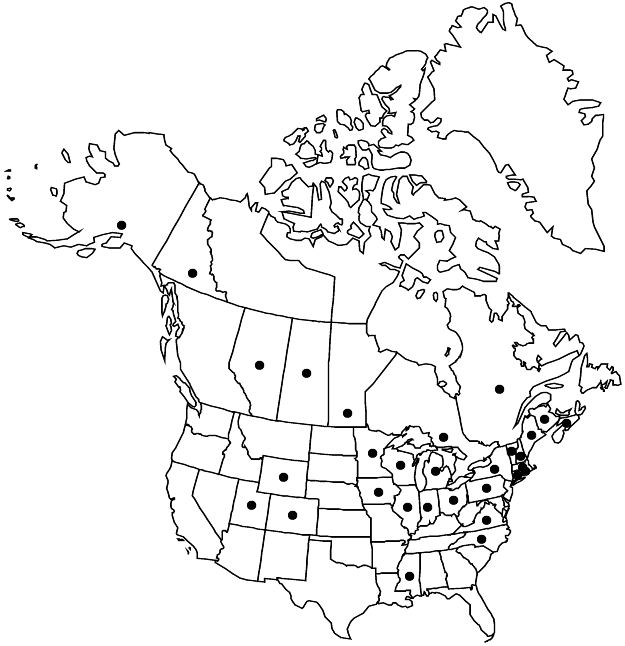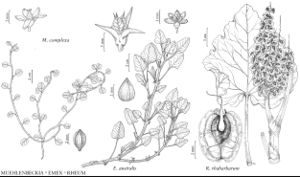Rheum rhabarbarum
Sp. Pl. 1: 372. 1753.
Plants 3–20 (–30) dm. Stems striate, often striped or suffused with red or pink, branched distally, hollow. Leaves: ocrea brown, loosely funnelform, 2–4 cm, margins strongly oblique, glabrous or puberulent with flattened, whitish hairs along veins; petioles of basal leaves pinkish green or reddish green, ca. equaling or longer than blade, thick, fleshy, those of cauline leaves absent distally; basal leaf-blades palmately veined with 5–7 basal veins, 30–45 (–60) × 10–30 cm, veins pubescent primarily along veins with flattened, whitish hairs. Inflorescences 250–500-flowered, 15–40 cm; peduncle 1–8 cm, glabrous. Pedicels articulated at or proximal to middle, 2–5 mm, glabrous. Flowers: tepals oblong-ovate, 2.3–4 × 1–2.5 mm, margins hyaline, apex obtuse. Achenes 6–10 (–12) × 6–11 mm including wings, 4–8 times longer than perianth; wings tan, veined, 3–4 mm wide, membranous. 2n = 44.
Phenology: Flowering Jul–Aug, fruiting Aug–Sep.
Habitat: Cultivated and often persisting long after abandonment, escaping infrequently
Elevation: 0-4000 m
Distribution

Introduced; Alta., Man., N.B., N.S., Ont., Que., Sask., Yukon, Alaska, Colo., Conn., Ill., Ind., Iowa, Maine, Mass., Mich., Minn., Miss., N.H., N.Y., N.C., Ohio, Pa., R.I., Utah, Vt., Va., Wis., Wyo., Eurasia
Discussion
The name Rheum rhaponticum Linnaeus appears to have been misapplied widely to R. rhabarbarum in North America. Rheum rhaponticum, European rhubarb, is the only member of the genus confined to Europe. Rare in the wild but widely cultivated, it is a diploid (2n = 22); R. rhabarbarum is a tetraploid (B. Libert and R. Englund 1989). A chromosome count of 2n = 44 reported for R. rhaponticum from Wisconsin (N. A. Harriman 1981b) probably is from R. rhabarbarum.
Many rheums have culinary and medicinal uses, some of which originated in Asia more than 2 millennia ago. Rheum rhabarbarum is used alone and in combination with various other fruits to make pies, jellies, jams, and wine. All parts of the plant contain oxalic acid, which has been implicated in cases of poisoning. However, other potentially poisonous compounds also are produced, including citric acid and anthraquinone glycosides (W. H. Blackwell 1990). Raw or cooked leaf blades are poisonous to humans and livestock if ingested in sufficiently large quantities. The petioles typically are used as food and contain mostly malic acid, which is nontoxic. Plants traditionally are propagated and moved by taking cuttings from larger plants.
Selected References
None.
Lower Taxa
"/2" is not declared as a valid unit of measurement for this property."thick" is not a number."dm" is not declared as a valid unit of measurement for this property.
